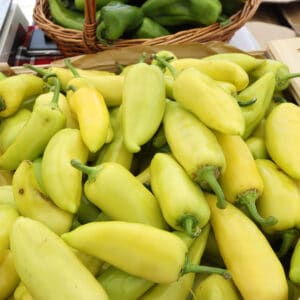Peperoncinis are a household favorite across America, Europe, and beyond. They are used in so many different types of meals, such as sandwiches or even as a creative addition to pastas or pizzas. A similar pepper, banana peppers, can often be confused as the same thing as a pepperoncini, but, despite being used interchangeably at times, they actually do have several differences.
 What are Peperoncinis?
What are Peperoncinis?
Peperoncinis are a small yellow pepper with Mediterranean origins that pack a somewhat sour taste. Peperoncini skin is wrinkly and has a pointed tip. Despite its Mediterranean start, they are quite popular in a wide range of recipes, including Italian and American cuisine as well. There’s a small bit of heat, but quite low on the Scoville Heat Unit scale (SHU), ringing in at around 100-500. Peperoncinis are typically pickled, which brings out an even more sour, zingy flavor.
What are Banana Peppers?
Banana peppers are aptly named as they resemble the shape and color of bananas. Contrary to peperoncinis, the pepper skin is smooth and shiny. They originated in Hungary but have expanded and are a popular sandwich topper in America. When it comes to heat, they are even milder than peperoncinis. They range from 0-500 on the Scoville Heat Unit scale. Banana peppers are consumed raw or pickled just like peperoncinis.
How to use Peperoncinis
When you’re looking for a stronger, sour flavor, opt for peperoncinis. Below are some popular ways to use peperoncinis in meals:
- Chicago Beef Sandwich: Adds a signature kick
- Atop Italian Chopped Salads: It’s common to see full, pickled peperoncinis on salads in Italian or Mediterranean restaurants.
- Italian Peperoncini Pasta: A simple, but flavorful pasta dish with sliced peperoncini — consider adding CINI sauce to the sauce.
- Peperoncini Pizza: Don’t overlook peperoncini as a topping for your pizza — red or olive oil base. CINI is even great on homemade pizza roll-ups! Consider pairing it with mozzarella cheese, sausage, olives, and red onions.
How to use Banana Peppers
When you’re looking for a slightly sweeter flavor and firmer texture, opt for banana peppers. Below is a popular use of banana pepper.
Stuffed Banana Peppers: Because of the firmer texture and long shape, you can stuff these peppers with ground meat, rice, or other ingredients. You can get creative with the way you prepare these through spices, or maybe even incorporating CINI sauce in them.
Depite their aesthetic and slight taste differences, many recipes that call for either pepper type can be substituted. So get creative and substitute CINI sauce whenever you see either of these mild peppers.
 Add CINI Sauce to Your Condiment Spread
Add CINI Sauce to Your Condiment Spread
If you’re a fan of peperoncini, then you’d be happy to know a vision and a blender came together to make a new condiment staple. CINI Sauce isn’t just a condiment; it’s a lifestyle for those brave enough to spice up their meals. So, whether you’re a pepperoncini fanatic or just looking to add some zing to your life, grab a bottle. Because life’s too short for bland food, so bring that #CINIZing!